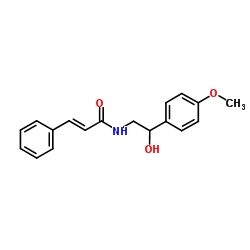| Description |
Aegeline, a main alkaloid, mimics the yeast SNARE protein Sec22p in suppressing α-synuclein and Bax toxicity in yeast. Aegeline restores growth of yeast cells suppressed by either αsyn or Bax. Antioxidant activity[1].
|
| Related Catalog |
|
| In Vitro |
Aegeline also prevents growth block in cells expressing the more toxic A53T α-synuclein mutant. Restoration of cell growth occurred through inhibition of increased ROS levels, mitochondrial membrane potential loss and nuclear DNA fragmentation, characteristics of apoptosis manifested in α-synuclein orBax-expressing cells[1]. Aegeline shows weak inhibitory effects on the histamine release from RPMCs, even though still succeed to inhibit when the histamine release induced by thapsigargin[2].
|
| References |
[1]. Derf A, et al. a natural product from the plant Aegle marmelos, mimics the yeast SNARE protein Sec22p in suppressing α-synuclein and Bax toxicity in yeast [published correction appears in Bioorg Med Chem Lett. 2019 Aug 15;29(16):2437-2438]. Bioorg Med Chem Lett. 2019;29(3):454‐460. [2]. Nugroho AE, et al. Effects of aegeline, a main alkaloid of Aegle Marmelos Correa leaves, on the histamine release from mast cells. Pak J Pharm Sci. 2011;24(3):359‐367.
|


